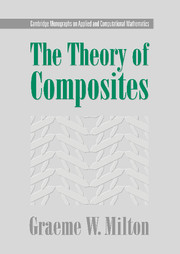Book contents
- Frontmatter
- Contents
- List of figures
- Preface
- 1 Introduction
- 2 Some equations of interest and numerical approaches to solving them
- 3 Duality transformations in two-dimensional media
- 4 Translations and equivalent media
- 5 Some microstructure-independent exact relations
- 6 Exact relations for coupled equations
- 7 Assemblages of spheres, ellipsoids, and other neutral inclusions
- 8 Tricks for generating other exactly solvable microgeometries
- 9 Laminate materials
- 10 Approximations and asymptotic formulas
- 11 Wave propagation in the quasistatic limit
- 12 Reformulating the problem of finding effective tensors
- 13 Variational principles and inequalities
- 14 Series expansions for the fields and effective tensors
- 15 Correlation functions and how they enter series expansions†
- 16 Other perturbation solutions
- 17 The general theory of exact relations and links between effective tensors
- 18 Analytic properties
- 19 Y-tensors
- 20 Y-tensors and effective tensors in electrical circuits†
- 21 Bounds on the properties of composites
- 22 Classical variational principle bounds
- 23 Bounds from the Hashin-Shtrikman variational inequalities
- 24 Bounds using the compensated compactness or translation method
- 25 Choosing the translations and finding microgeometries that attain the bounds†
- 26 Bounds incorporating three-point correlation functions†
- 27 Bounds using the analytic method
- 28 Fractional linear transformations as a tool for generating bounds†
- 29 The field equation recursion method†
- 30 Properties of the G-closure and extremal families of composites
- 31 The bounding of effective moduli as a quasiconvexification problem
- Author index
- Subject index
26 - Bounds incorporating three-point correlation functions†
- Frontmatter
- Contents
- List of figures
- Preface
- 1 Introduction
- 2 Some equations of interest and numerical approaches to solving them
- 3 Duality transformations in two-dimensional media
- 4 Translations and equivalent media
- 5 Some microstructure-independent exact relations
- 6 Exact relations for coupled equations
- 7 Assemblages of spheres, ellipsoids, and other neutral inclusions
- 8 Tricks for generating other exactly solvable microgeometries
- 9 Laminate materials
- 10 Approximations and asymptotic formulas
- 11 Wave propagation in the quasistatic limit
- 12 Reformulating the problem of finding effective tensors
- 13 Variational principles and inequalities
- 14 Series expansions for the fields and effective tensors
- 15 Correlation functions and how they enter series expansions†
- 16 Other perturbation solutions
- 17 The general theory of exact relations and links between effective tensors
- 18 Analytic properties
- 19 Y-tensors
- 20 Y-tensors and effective tensors in electrical circuits†
- 21 Bounds on the properties of composites
- 22 Classical variational principle bounds
- 23 Bounds from the Hashin-Shtrikman variational inequalities
- 24 Bounds using the compensated compactness or translation method
- 25 Choosing the translations and finding microgeometries that attain the bounds†
- 26 Bounds incorporating three-point correlation functions†
- 27 Bounds using the analytic method
- 28 Fractional linear transformations as a tool for generating bounds†
- 29 The field equation recursion method†
- 30 Properties of the G-closure and extremal families of composites
- 31 The bounding of effective moduli as a quasiconvexification problem
- Author index
- Subject index
Summary
If cross-sectional photographs of a material are available and the microstructure is isotropic, then one can determine the two- and three-point statistics of the material, in addition to the volume fractions of the phases. This section shows how to utilize this information to obtain improved bounds on the effective properties.
A brief history of bounds incorporating correlation functions
Beran (1965) first recognized that conductivity bounds incorporating three-point correlation functions could be obtained by substituting appropriate trial fields into the classical variational principles. Beran and Molyneux (1966) obtained similar bounds on the effective bulk modulus. For statistically isotropic two-phase cell materials Miller (1969a, 1969b) considered these bounds and found that they reduced to expressions involving the cell shape parameter G given by (15.44). McCoy (1970) used the same approach to obtain bounds on the effective shear modulus. The conductivity, bulk modulus, and shear modulus bounds were tightened and extended to multiphase three- and two-dimensional cell materials by Pham (1996, 1997).
Silnutzer (1972) extended the Beran conductivity bounds to fiber-reinforced materials, that is, to two-dimensional composites. Beran and Silnutzer (1971) found simplified expressions for these bounds for two-phase cell materials.
Schulgasser (1976) recognized that the two-dimensional bounds of Silnutzer (1972) could be simplified for any two-phase composite, and not just cell materials, and found that they only depended on a single geometric parameter. A similar simplification was found for the three-dimensional Beran conductivity bounds (Torquato 1980; Milton 1981b; Torquato and Stell 1985), for the Beran-Molyneux bulk modulus bounds, and for the McCoy shear modulus bounds (Milton 1981a).
Information
- Type
- Chapter
- Information
- The Theory of Composites , pp. 553 - 568Publisher: Cambridge University PressPrint publication year: 2002
